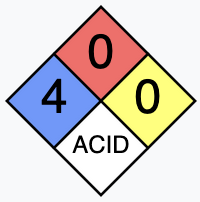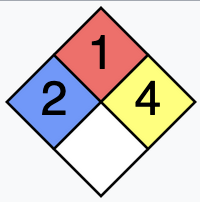Skeleton Trivia for Monday, 2025-06-16
Diamonds are forever
Hiya Skeleton Crew,
Last Thursday’s themie was Dads ’n’ Grads! I hope Father’s Day ’n’ graduation season has been treatin’ youse all OK.
Answers to Last Time
Dad’s Root Beer lays claim to bein’ the first product to ever be sold in the six-pack format.1
The graduated cylinder is the bit a’ labware that occupies that awkard middle where ya need a li’l more accuracy than a regular ol’ beaker, but ya don’t need to be so precise as to get a volumetric thing.
Today’s Trivias
Trivia 1
It was brought to my attention that when I encouraged youse guys to imagine pourin’ hydrofluoric acid into some glassware last week, that was probably not such a great idea, ’cause that stuff can DISSOLVE GLASS!
Yikes-a-roo!!!
So, uh, yeah. I guess it’s still fine to imagine puttin’ hydrofluoric acid (HF) in glass, but please don’t ACTUALLY do that!2
Have ya ever seen those fire diamonds that tell ya how different substances are dangerous in different ways? For example, here’s it for HF:

This means HF poses a real bad health hazard (blue) but it’s not particularly flammable (red) or reactive (yellow).3
Although you or I’d call it a “fire diamond” or “safety square”, the official name is the not-quite-as-catchy “NFPA 704”. The standard was first developed by the Charlotte Fire Department after a particularly bad chemical fire at the Charlotte Chemical Company in 1959 that left several firefighters with real bad injuries.
What happened is the firefighters thought they were puttin’ out a fire in a vat full a’ kerosene, but unfortunately it also had some metallic sodium in it! Which was a problem, because sodium’s a member a’ what leftmost group on the periodic table, whose members are all highly reactive with water?
(Oh, an’ no points for just callin’ it Group 1 or IA or whatever: I want what scientists call the “trivial name”. This IS trivia, after all!)
Trivia 2
Can ya tell me what substance, invented by German chemist Julius Wilbrand in 1863, has got this fire diamond?

It was actually used as a yellow dye for quite a while; its more famous use was only discovered in 1891 by a fella named Carl Häussermann.
OK then
Byeeeeeeeeeeeeeeee
If ya give me your email address, I’ll send some trivias to ya! No joke!!!
I really ain’t gonna go to bat for this fact. They say they started usin’ the six-pack format “invented by the Atlanta Paper Company in the 1940s”—but I found a bunch a’ other claims, too. Take your pick between Pabst inventin’ the six-pack in ’40s, Ballantine in 1938, or even Coca-Cola all the way back in ’23. PLUS the Illinois Tool Works says their Hi-Cone six-ring carrier “transform[ed] the beverage and packaging industries” in the ’60s! Although I guess the plastic-ring six pack for aluminum cans is different from the paper one ya use for bottles? I dunno! It’s all kinda a muddle. ↩
Unless ya, like, know what you’re doin’? I mean probably the best plan is not to get your chem lab ideas from a trivia newsletter. ↩
Oh, an’ the word ACID in the white square means it’s an acid, in case ya didn’t figure that one out. ↩